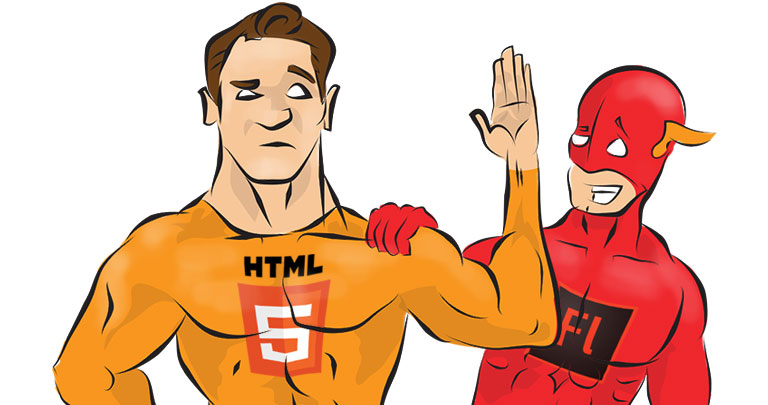
It's been only 8 years since Steve Jobs announced the death of Flash, but in the field of computing, that's a long time. Steve Jobs is no longer in this world now, but his prophecy came true. His decision to block the use of Flash on his new iPhone might have seemed risky at the time, but for all good reasons it was worth taking a risk that time. The slow and heavy Flash was only an obstacle to one of the most revolutionary gadgets of the 21st century.
There is already a date for the official death of Flash
Flash was the king in multimedia creations, animations and interactive web pages for two decades, during the PCs hegemony. In July 2017, shortly after Google decided to stop supporting Flash-based technology in its Ads, Adobe finally accepted the inevitable reality: they won’t continue to support the Flash Player plug-in as of 2020. The announcement by Microsoft, Mozilla and Google to disable the default plug-in in their browsers at the beginning of 2020 was a big news in the tech world.
Why has Flash died?
In April 2010, Steve Jobs published an article called "Thoughts on Flash", where he argued that Flash could never be adapted to the era of mobile phones, because it was created for PCs. He thought that Flash would limit the iOS experience. In summary, Flash would die for 5 reasons:
- Incompatibility with Touch functionalities.
- Reduce battery life by half.
- High insecurity and poor performance.
- The "Full Web".
- Sub-standardized quality of third-party development tools.
That is why he advocated replacing Flash with HTML5 and CSS3. But during the life of Jobs, HTML5 was still a simple project that had not yet been fully implemented by major browsers. In 2011 began its full implementation in web browsers. By the end of 2013, Chrome, Firefox, Internet Explorer, Opera and Safari had adopted HTML5 quite well.
In January 2015, YouTube adopted HTML5 as the default player. According to statistics from 2016, Flash was used by less than 50% of smartphones, while HTML5 was used by 97% of PCs and mobile devices connected to the Internet.
What is HTML5?
HTML is the acronym for "Hypertext Markup Language", a markup language used as standard by the World Wide Web, HTML5 being the fifth generation of this standard. In short, it is the code with which this page has been built.
HTML5 added new elements such as the <audio> and <video> tags, which allowed multimedia content to be played in a lighter, safer, and more responsive way than Flash. It adjusts automatically according to the requirements of different mobile devices. This made it the ideal multimedia standard for mobile world, where every minute of battery and every megabyte of RAM matters.
For all this, any team of developers should be prepared to migrate their Flash applications to HTML5, if not already done so.
Advantages of Flash to HTML5 conversion
If you are a programmer, the first is to formulate an action plan. Evaluate your content in Flash and decide if you need to remove the app/course/program; convert content to HTML5; or rebuild/redesign the app, course or other content. For conversion, there are several tools available, such as Adobe Edge and Google Web Designer.

The main advantages would be:
- Your content will be compatible with multiple devices: This is the main reason why you should convert your Flash content to HTML5 format. In this way, it will be possible to access your content from most mobile devices. For example, most people today mainly use smartphones and tablets to enter online courses.
- The content can be used offline: Today, it’s important for a seller to be able to show their contents in areas without internet connection. For example, you cannot provide offline access to content developed in Flash. But HTML5 is different. You can download the course and use it offline as well.
- You can take advantage of the full potential of your content: HTML5 allows the creation of web apps that can be used on any platform, offering the way to learn online for any device.
- HTML5 eliminates the need to use plug-ins: It’s impossible to use multimedia content from Flash-based courses unless the plug-in is installed. HTML5 eliminates this problem by making it possible to play multimedia without plug-ins.
- Your business will be more profitable: In an era where there will be less support for Flash and fewer programmers using it, you can save a lot of money by making the transition to HTML5, avoiding costs such as dealing with Flash vulnerabilities, possible hacks, downloading updates, etc.
Conclusion:
From all the aforementioned facts about the journey of flash, till its expected death date and the future opportunities existing with the advanced features of HTML5 technology, it is recommended for all the technology community to be ready for flash to HTML5 conversion in the coming days. This is required, so that all your future web and mobile technology products/services should meet high level of standard in this competitive era. In brief, what do you expect from starting the conversion of Flash to HTML5?
0 Comment(s)